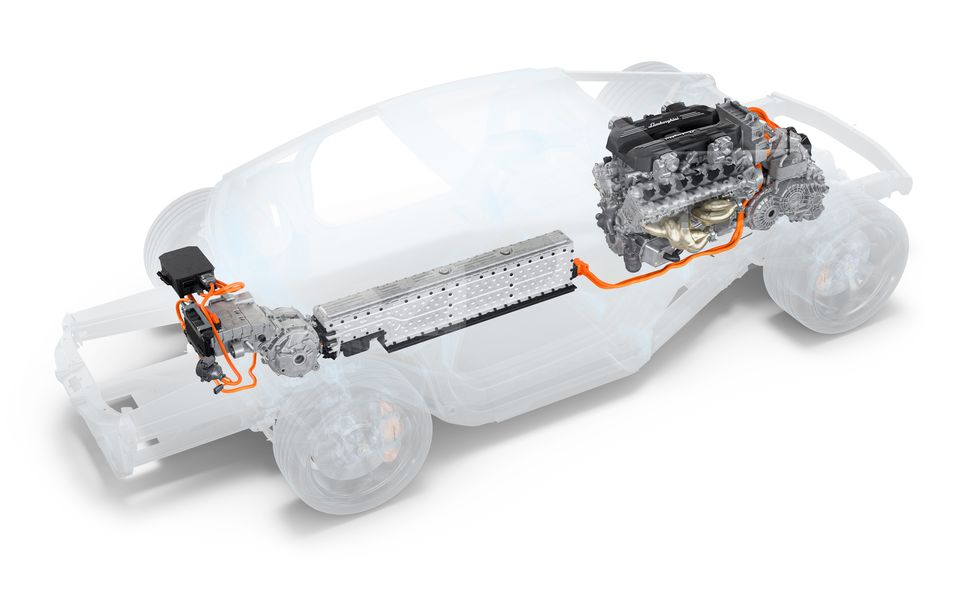- Lamborghini announces a new, hybridized 6.5-liter V-12 powertrain that makes up to 1001 horsepower.
- It features three electric motors, two up front and one integrated to a new, Lamborghini-designed, eight-speed double-clutch transmission.
- The full car will be shown—and its name revealed—at the end of the month.
We can’t show you what the replacement for the Lamborghini Aventador looks like yet, or even tell you its name—the company refers to it exclusively by the internal code, LB744. But we can share details on its extraordinary new plug-in-hybrid powertrain.
The good news is the continued existence of a naturally aspirated V-12 engine, one that has been core to the appeal of the company’s more expensive models since its foundation. The new 6.5-liter L545 engine is effectively a heavy development of the one that powered the Aventador, but with more power, more revs, less weight, and a compression ratio raised to 12.6:1. Lamborghini says the new engine’s mass of 481 pounds makes it 37 pounds lighter than the Aventador’s V-12, while its power output has increased to 814 horsepower delivered at a searing 9250 rpm—with the limiter not calling time until 9500 rpm. It also makes a peak of 535 pound-feet of torque at 6750 rpm. But while the Aventador’s V-12 sent power forward to a single-clutch gearbox positioned ahead of it, the new engine has been flipped by 180 degrees, with power going through a new, Lamborghini-designed eight-speed dual-clutch transmission mounted transversely behind it.
But this V-12 is only one part of the new powertrain, being assisted by no fewer than three electric motors. At the front, a pair of axial-flux motors power each wheel separately, allowing torque vectoring. There is no mechanical link from the engine to the front axle; the LB744’s all-wheel-drive system is always part electric.
At the back, a third motor is incorporated into the transmission, which due to a clever clutching mechanism can switch between acting as starter motor and generator or adding power to the rear axle. Each motor can deliver up to 148 horsepower, although the combined peak is always less than three times that due to the current flow supported by the battery. The maximum combined output is quoted as an impressively potent 1001 horsepower—slightly more than the Ferrari SF90 Stradale.
Electrical charge is stored in a compact 3.8-kWh battery pack that sits in what would previously have been considered the transmission tunnel within the cabin, allowing a low seating position on either side of it. Lamborghini hasn’t released a weight claim for the battery, but for reference the claimed capacity is far less than the corresponding figures for the Ferrari 296GTB and SF90, and also the McLaren Artura, suggesting the Lambo’s should be lighter and provide fewer electric miles. We do have weight figures for the front motors—41 pounds—and the double-clutch transmission, which is 425 pounds including the weight of the integral electric motor.
When depleted, the battery can be recharged from a socket, via regenerative braking using the front motors, or with the V-12 acting as a generator. The latter is claimed to completely replenish the pack in just six minutes. Therefore, it should be possible to be quickly brought back to full strength when driven on track. Lamborghini also says the new DCT gearbox will support a “continuous downshifting” function, holding the left paddle while decelerating progressively and selecting the lowest possible gear as speed falls.
Lamborghini promises to release more technical details of the new car before the finished version is formally unveiled at the end of the month. We’ll keep you posted.
European Editor
Mike Duff has been writing about the auto industry for two decades and calls the UK home, although he normally lives life on the road. He loves old cars and adventure in unlikely places, with career highlights including driving to Chernobyl in a Lada.

